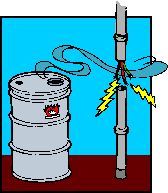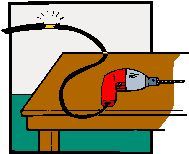| Page 3 |

|
|
1 - Electrical Safety
2 - Page 2 3 - Page 3 4 - Page 4 5 - Page 5 6 - Page 6 |

 |
Ever wonder why at gas stations the signs tell you to turn off cell phones while pumping gas?
Fire can be start from a spark when surrounded by flammable vapor, such as gasoline, solvent, degreaser, and other chemical with a flash point below lOO F (37. 80C).
On May 14, 2004 at a Mobile Gas Station in New Paltz, New York, flames shot up around a 21-year-old college student whose cell phone rang while he was pumping gas. Firefighters said Matthew Erhorn received minor burns when the cell phone ignited vapors coming from the car's fuel tank as it was being filled.
The fire was immediately put out by the service station's fire suppression system, using an oxygen-killing powder. That covered other cars in the gas station parking lot as well as nearby trees.
It doesn't take much of a charge to ignite gasoline vapors, New Paltz fire chief Patrick Koch explained. "Anything, really. Women's nylon stockings when they get out of a vehicle, that can cause a spark, too." It has been advised in the past to ground yourself before handling the gas pump.
 |
Electrical Equipments remain the number one cause of fires in offices and laboratories. If you see a frayed wiring do not attempt to fix it yourself but inform your supervisor or the facility coordinator to replace the wiring.
Electrocution Due to Improper Use of CommonLab Equipment, a true case forwarded by the American Industrial Hygiene Association.
Dr. X was conducting an experiment related to plant growth. He needed to expose the plants to light for specific time-periods each day. Accordingly, he had a portable fluorescent lighting rack constructed and mounted on a wooden frame. He also obtained an electric timer to automatically turn the lights on and off. The light fixture was plugged into the timer, which was plugged into the wall outlet. However, since the timer only accepted a two prong plug, an adapter was used to allow the three prong plug of the lighting rack to be used with the two prong outlet of the timer.The Incident
Dr. X adjusted the timer so that the lights would be on and plugged the timer into a standard 3-prong wall outlet. Then another person in the lab noticed Dr. X grasping the lighting rack and appearing to be rigid. A third person grasped Dr. X by the shoulders and pulled him away from the lighting rack. CPR was performed on him until EMS arrived. Dr. X was transported to a hospital where he was pronounced dead.The Investigation revealed the following details:
- A potential difference of 397 volts was measured between the metal fluorescent light fixture and the adjacent stainless steel sink. (There should not have been any potential difference).
- Both the fixture and the wall outlet were found to be wired correctly.
- The light fixture was rated for 800 mA, but the lamps used were 1500 mA.
- The transformer in the ballast was found to have short circuited to the case.
What Probably Happened
Use of bulbs drawing more current than approved for the fixture caused overheating of the ballast resulting in melting of insulation around the transformer coil. This allowed an energized transformer wire to touch the metal cover of the ballast which in turn energized the metal fluorescent fixture. The lights probably continued to function since they were wired correctly.
When Dr. X grasped the fixture, some part of him probably brushed against the nearby metal sink. This completed a circuit to ground through Dr. X, electrocuting him.
Preventing this Fatality
As with many very serious accidents, a number of factors were involved, any one of which could have prevented this fatality.
- If overrated lamps had not been used, the ballast would probably not have overheated and failed.
- If the ground wire connection between the light fixture and the plug not been interrupted by the "cheater" adapter and the two-prong timer, the fixture would have safely shorted to ground tripping the circuit breaker when the equipment was plugged in before Dr. X touched it.
- Had the standard outlet near the sink been Ground Fault Circuit Interrupter (GFCI) protected (as it should have been because it was near a sink), the GFCI would have tripped at the first flow of current through Dr. X immediately cutting off power to the fluorescent fixture and saving his life.
- These electrical safety violations cost Dr. X his life. If any one of them had been corrected before the incident, Dr. X would still be researching plant growth.
What can I do to prevent something like this from happening in my lab?
1)Follow manufacturer's recommendations for use of electrical equipment. Do not use electrical equipment for a task it is not designed for.
2) Generally, equipment used in research should have a 3 prong plug or be double insulated. Equipment with neither of these features are less safe but may meet electrical codes. A 3 prong plug must always go into a 3 prong outlet. Do not use a "cheater" plug or pull out the 3rd prong.
3) Do not use multiple cube taps in a standard outlet. If you must plug more than two pieces of low demand equipment into a standard outlet, use a fused power strip that will trip if too much power is used.
4) Make sure that any outlet near a sink or other water source is Ground Fault Circuit Interrupter (GFCI) protected. If you have a GFCI, periodically test it by plugging something into it and pushing the "test" button. The equipment should turn off and then turn it back on.
5) If you see a person being electrocuted, DO NOT TOUCH HIM! The electricity can go though you too. If possible, remove the power (pull plug or trip circuit breaker), or use a non-conductive item (e.g. wooden broom handle) to pry him away from the contact.
6) Above all, do not disable any electrical safety feature expecting that another safety feature will protect you. In the incident described above, if proper lamps were used, the ballast could still have been defective from other causes. Also, GFCIs can be defective. That is why they should be periodically tested.
7) Check that power cords are in good condition.
8) Do not use extension cords as a substitute for permanent wiring.
| << Previous 1 2 [3] 4 5 6 Next >> |

